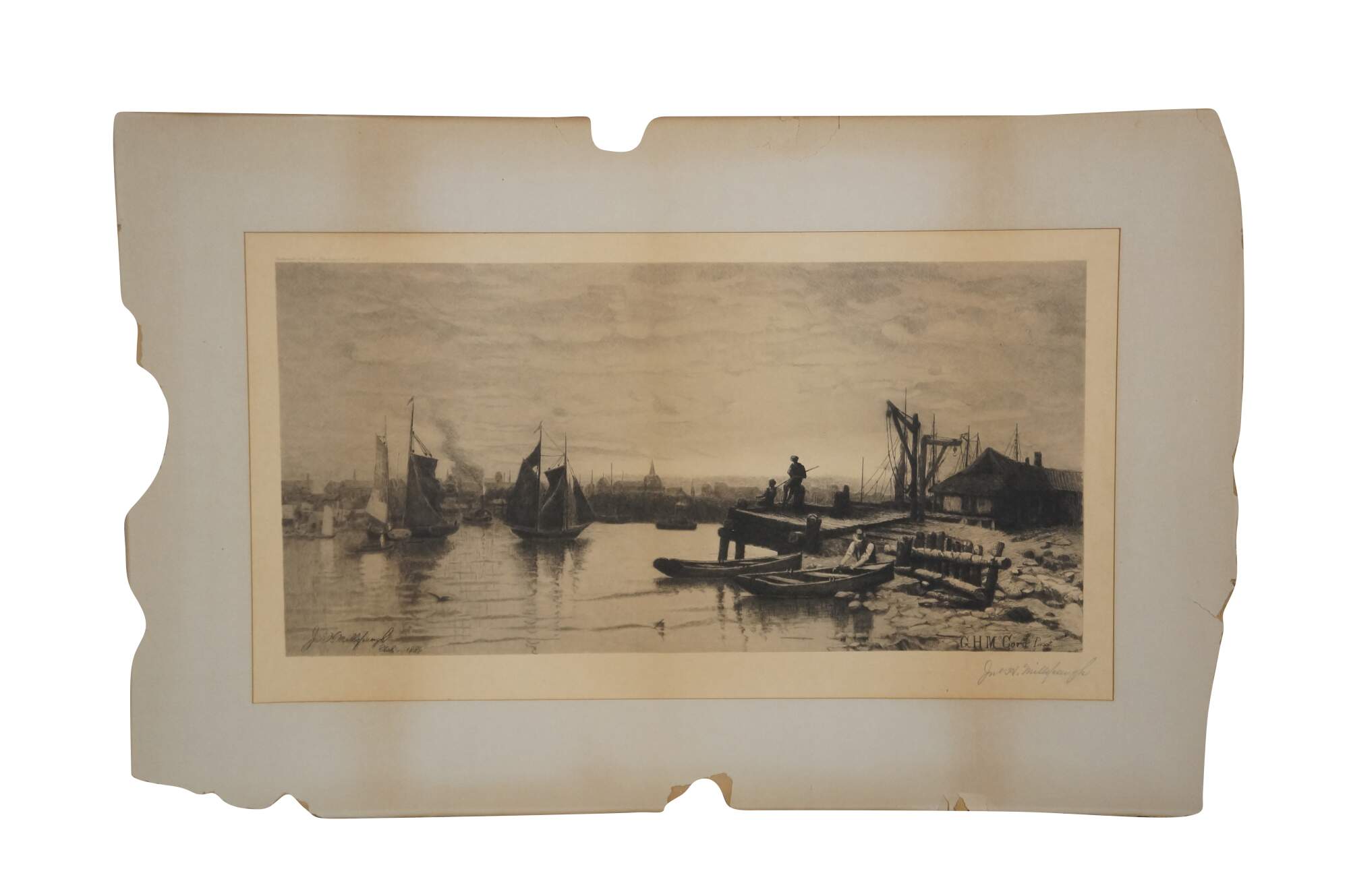
Shipping:
Free Shipping Included
Delivery:
Estimated 2-15 Business Days
Payments:
Credit Card, Check, Cash, PayPal, Apple Pay, Venmo
Returns:
30 Days 100% Money Back Guarantee, Buyer Pays Return Shipping
Description
Late 19th century black and white signed etching by John Hill Millspaugh after a painting by George Herbert McCord. Nautical landscape showing sailboats near a small dock with figures and a town across the water. Signed in plate Jn H Millspaugh Etch'r 1886, lower left and G.H. McCord Pinxit, lower right. Pencil signed, lower right. Copyright 1887 by C. Klackner, 17 E 17th St, N.Y. Paper mounted on cardstock; gray mat; unframed.
"George McCord (August 1, 1848– April 6, 1909) was an American painter, known for atmospheric marine and landscape paintings in oil, pastel, and watercolor and for black and white drawings. McCord was born in New York City and remained primarily a resident in Brooklyn although he traveled widely and from 1883 also had a studio in Morristown, New Jersey. He was part of the second generation of Hudson River School painters. He studied at the Hudson River Institute, the Claverack Academy in Claverack, New York." (Wikipedia)
"The following information is from the research and writing of Michael McCue, art historian and curator: John Hill Millspaugh (1822 - 1894), born at Crawford in New York State, became a painter and etcher in the late 19th century and earned much respect for the quality of his work. However, he is little known today. He was raised at Crawford on the Hudson River. At age 16, he went to New York City to apprentice as a stereotyper, which was highly detailed work creating relief plates of metal from original woodcuts. By the mid 1840s, he was working in Waverly as a stereotyper, and then moved to Ithaca where he met his wife, Marion Elizabeth Cornell. Her uncle, Ezra Cornell became exceedingly wealthy from the telegraph business and founded Cornell University. John had a brother, Edward, who showed early talent as an artist and studied with Henry Inman, a leading Hudson River School painter. He died at age 31 from smallpox. Hoping to carry on his brother's work, John began studying art, and his most influential teacher was George Lafayette Clough (1824-1901), also a Hudson River School painter. John Millspaugh's career between 1851 and 1871 remains undocumented, but according to his obituary, he considered himself an amateur artist. It is thought he made his living during this period as a stereotyper. A description of one of his oil paintings shows a family picnic, and one person reported seeing an etching of Cornell University. The only known painting in a public collection is dated 1872 and is titled "Autumn in the Susquehannock." It is a pastoral landscape in the Hudson River School style and is in the Palmer Art Museum at Pennsylvania State University. In 1872, Millspaugh left Ithaca for New York City to take a job for an undetermined period of time at the Customs House. However, his family suffered when a severe depression, the Panic of 1873, hit a year later, and his son had to leave college. By 1882, he reportedly was getting attention in New York City for his etching, an art form that was extremely popular at that time and tried by many artists. Millspaugh was invited to join the New York Etching Club, the country's first organization specifically devoted to that medium. His etchings are highly detailed, and most of them depict quiet landscapes. The earliest one published was likely "Evening on the Delaware," by fine-art publisher Christian Klackner. One of these works is in the Parrish Art Museum at Southampton, Long Island. Millspaugh collaborated with Boston painter and etcher Louis K Harlow to publish works through Klackner. After 1889, Millspaugh did mostly self publishing. At an undetermined date, he left Manhattan and returned to Ithica to live. He and his wife spent the winter of 1893-94 in Denver, Colorado, and he died on the return trip to Ithaca." (Source: askART)
Condition
Wear and distressing from age, foxing / discoloration; tears/damage to mat
Dimensions
28" x 18" / Sans Mat - 22" x 12" (Width x Height)